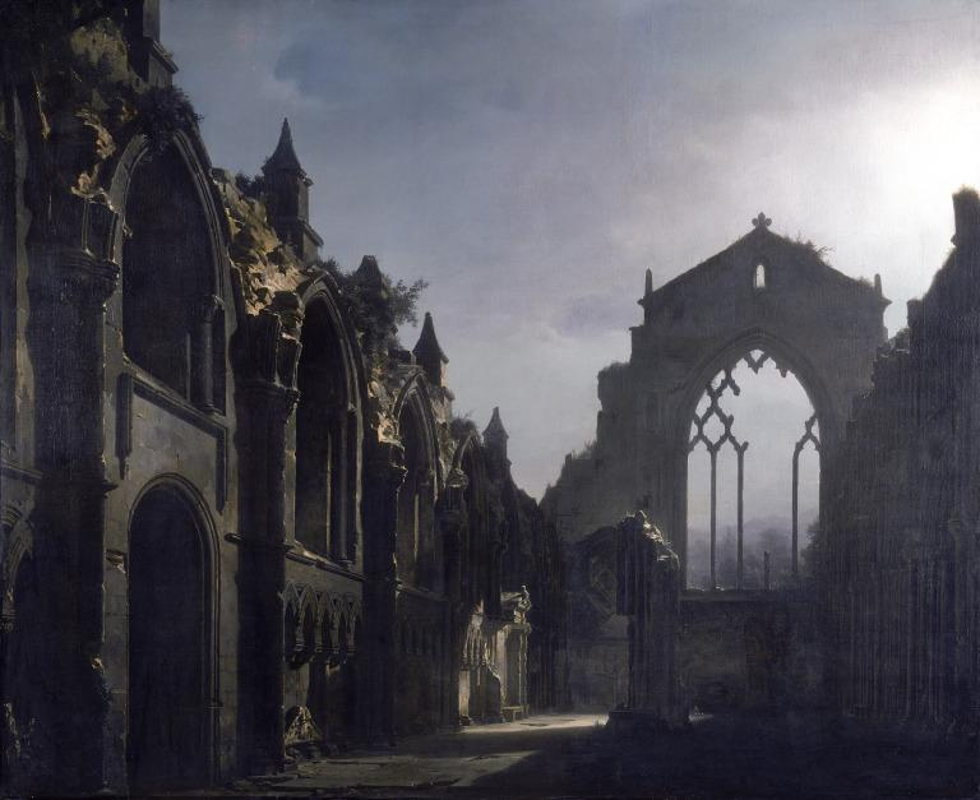Thrill and Dread: The Poetics of Ruins

For as long as he can remember, Mike Pinnington has been visiting one particular artwork again and again. Here, with reference to a painting by Louis Daguerre, he considers our obsession with ruins and their depiction…
The ruined chapel grabs and holds your attention from the moment you see it. Ominous clouds gather above the distinctly gothic-feeling night scene. In spite of their menace, however, they can do little to fully occlude a sublime moon – the luminous beams of which make you want to squint. Battling the clouds’ roiling malevolence, a celestial shaft of light lands on the floor, illuminating a section of ruins. It reminds us that this place – although shorn of past glories and, indeed, a roof – remains in some way sacred. Nonetheless, with its blackened columns and fractured, empty window frames, there is just as much shadow here as there is illumination. And, not unlike a vampire (or some other child of the night), it makes for a foreboding as well as a seductive sight.
Here lie the Ruins of Holyrood Chapel. Haunting yet magnificent, the oil painting, by artist Louis Daguerre (he of the Daguerreotype photography process), captivates the eye and the mind. And, if you believe in such a thing, the soul. I have stood before this painting many times. Seemingly unable to resist its clarion call, it rewards repeat viewings; the more you look, the more detail you unearth, and the greater its pull. It carries the ravages and patina of time, nature’s slow but inevitable reclamation of space. If forced to choose, I would say that it was my favourite artwork on display in Liverpool. Why, I wonder. What is it that holds my gaze so fully each and every time I visit it? I walk away, only to return for one last look (knowing there will also be a next time).
I delve into the painting’s history. In the sixteenth century, the chapel itself was sacked and the roof stripped of lead by invading English armies. Although there is no record of his visit, Daguerre painted it twice; in the other version, its non-identical twin, the artist included the figure of a woman visiting a tomb (belonging to a former Duchesse de Grammont, no less). This was exhibited by Daguerre at the Paris Salon of 1824. He also created and exhibited dioramas of the same subject. Why was Daguerre drawn to depict the chapel again and again? To render so convincingly the scene of decay?
Hardly alone in his fascination with such subject matter, in painting the scene, Daguerre had joined a growing pantheon of artists, writers and philosophers from the eighteenth century onwards who, together, had been part of a craze to capture and discuss – even invent new – ruins. If this seems ridiculous from our sophisticated twenty-first century vantage point, we share the same fascination today – closely related to our preponderance for what has become known as dark tourism. Modernist architecture crumbles in former Soviet states; so-called Stalkers wander through the aftermath of Chernobyl; vultures pick over Detroit, a city beset by apparently permanent downturn. Meanwhile, photography books of these ruin-porn ‘destinations’ fly off shelves.
Writing in 1767, Daguerre’s countryman, the philosopher Denis Diderot, said: “Our glance lingers over the debris of a triumphal arch, a portico, a pyramid, a temple, a palace, and we retreat into ourselves; we contemplate the ravages of time, and in our imagination we scatter the rubble of the very buildings in which we live over the ground; in that moment solitude and silence prevail around us, we are the sole survivors of an entire nation that is no more. Such is the first tenet of the poetics of ruins.”
Ruins, then, speak to something fundamental within us. From the ether and amid the rubble we spy a portal to the past (be it recent or ancient); our imaginations, in overdrive, plunged headlong into fertile ground, vividly conjure how we used to live. But this portal also serves – undeniably – as a memento mori, a stark reminder that epochs end, and civilisations fall, eventually crumbling into dust to be reclaimed by the land.
Even when faced with such logic, however, my – our collective – fascination with depictions of ruins remains. ‘Remains.’ A word whose synonyms aptly number ‘persists’, and ‘ruins’. Intellectually, then, I know what makes the painting so mesmerising. This, though, does nothing to diminish the feelings it provokes. Thrill and dread combine, like standing on time’s precipice, building a kind of bridge to a past that isn’t mine. We know we must look forwards, and yet this almost ineffable feeling, inevitably, draws me back.
Mike Pinnington
Ruins of Holyrood Chapel, by Louis (Jacques-Mandé) Daguerre (circa 1824), is on display at the Walker Art Gallery





